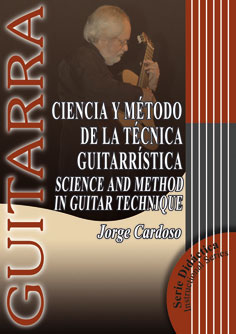- Contacto |
-
Teléfono
|
(+34) 91 542 72 51.
We’re open from Monday – Friday 10h-13:30h / 17:00-20:00h and Saturdays 10h-13:30h (GMT + 1).
In 2024, we will be closed for holidays on the 1st and 6th January, 28th, 29th, and 30th March, 1st, 2nd, and 15th May, 25th July, 15th August, 12th October, 1st and 9th November, 6th, 7th, and 25th December.
Our shop is located in Calle Campomanes nº 4, Madrid 28013 España (Ópera Metro Station) - Ayuda |
- Lista de precios |
- Situación de pedido |
- Acceso Mayoristas
- 🚚 📦 WORLDWIDE SHIPPING ✈️ 🌍
Science and Method in Guitar Technique by Jorge Cardoso
This book came first in an exhaustive historical comparative survey published in the prestigious French magazine " Les Cahiers de la Guitare " . Written in 1973, it revolutionised musicians' approach to instrumental technique. Underpinned by solid, current scientific evidence and the most efficient guitar experience gleaned from the history of the instrument and long-forgotten traditions, it takes an in-depth look at how we can develop an infinite range of fine skills on the instrument. Since its publication this book has been used as a tool for technical development and training , as a classic reference work for numerous treatises on other instruments and in the prevention of work-related illnesses and problems common among players.
Index:
FIRST PART
1.- Arm muscles
Shoulder muscles
Upper arm muscles
Forearm muscles
Hand muscles
Hand muscle functions
Anatomical considerations
2.- Motility
Muscle contraction - Pyramidal tract
Extrapiramidal tracts - Cerebral cortex - Cerebellum
The sensory ‘engram’ for motor activities
General considerations
3.- The physiology of exercise
Training - Fatigue
General considerations
4.-Psychology
Consciousness
Subconsciousness
Unconsciousness
Perception and attention
Habit - Memory
5.- Learning
Learning curves
Spreading practice sessions out
Partial and total learning
Study method
PART TWO
6.-Posture for guitarists
7.- Scales
Preliminary exercises
Diatonic scales
Chromatic scales
Exercises
8.- Arpeggios
Three elements – four elements
Six elements – eight elements
Other arpeggios
Arpeggios on non-adjacent strings
Some arpeggio applications
Accents
Arpeggios with the thumb
9.- Slurs
Two and three note slurs
Four and five-note slurs
Slurs in the notes of a chord (grace notes)
10.- Tremolo
11.- Stretching exercises
Lengthways - Sideways
12.- Chords
13.- Barré exercises
14.- Left hand motion
Format A4, 210 Pages
Español ans English.
This book came first in an exhaustive historical comparative survey published in the prestigious French magazine " Les Cahiers de la Guitare " . Written in 1973, it revolutionised musicians' approach to instrumental technique. Underpinned by solid, current scientific evidence and the most efficient guitar experience gleaned from the history of the instrument and long-forgotten traditions, it takes an in-depth look at how we can develop an infinite range of fine skills on the instrument. Since its publication this book has been used as a tool for technical development and training , as a classic reference work for numerous treatises on other instruments and in the prevention of work-related illnesses and problems common among players.
Index:
FIRST PART
1.- Arm muscles
Shoulder muscles
Upper arm muscles
Forearm muscles
Hand muscles
Hand muscle functions
Anatomical considerations
2.- Motility
Muscle contraction - Pyramidal tract
Extrapiramidal tracts - Cerebral cortex - Cerebellum
The sensory ‘engram’ for motor activities
General considerations
3.- The physiology of exercise
Training - Fatigue
General considerations
4.-Psychology
Consciousness
Subconsciousness
Unconsciousness
Perception and attention
Habit - Memory
5.- Learning
Learning curves
Spreading practice sessions out
Partial and total learning
Study method
PART TWO
6.-Posture for guitarists
7.- Scales
Preliminary exercises
Diatonic scales
Chromatic scales
Exercises
8.- Arpeggios
Three elements – four elements
Six elements – eight elements
Other arpeggios
Arpeggios on non-adjacent strings
Some arpeggio applications
Accents
Arpeggios with the thumb
9.- Slurs
Two and three note slurs
Four and five-note slurs
Slurs in the notes of a chord (grace notes)
10.- Tremolo
11.- Stretching exercises
Lengthways - Sideways
12.- Chords
13.- Barré exercises
14.- Left hand motion
Format A4, 210 Pages
Español ans English.
















